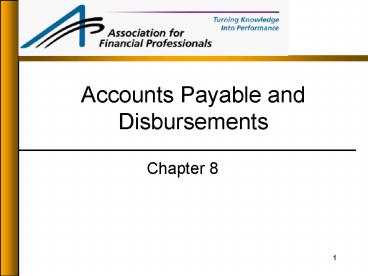Accounts Payable and Disbursements PowerPoint PPT Presentation
1 / 19
Title: Accounts Payable and Disbursements
1
Accounts Payable and Disbursements
- Chapter 8
2
Strategize
- Acquire an understanding of the following
- The objectives of accounts payable and
disbursement systems - The components of disbursement float
- Disbursement products and their applications
- The accounts payable function
- Check reconciliation and supporting services
- Technological developments in accounts payable
3
Describe 1
- Describe four objectives of accounts payable and
disbursement systems. - 1. Accounts payable process
2. Disbursement cost reduction
3. Disbursement float management
4. Other considerations in disbursement
- Information access
- Fraud prevention
- Relationship maintenance
4
Describe 2
- Describe the three components of disbursement
float.
1. Mail float 2. Processing float
3. Clearing float
5
(No Transcript)
6
Key Issue
- How can I disburse
- my funds?
- What are the advantages
- and disadvantages of
- each method?
7
Describe 3
- Describe three types of disbursement systems.
1. Centralized check issuance 2. Decentralized
check issuance 3. Checks written at local level
on a centralized disbursement bank
8
Describe 4
- Describe five advantages and three disadvantages
of centralized check issuance.
- Advantages
- Concentrated excess cash
- Improved access to cash position information
- Improved coordination for cash inflows and
outflows - Restricted access
- Reduced cost
- Disadvantages
- Potential increase in disbursement float
- Delayed payments to suppliers resulting in lost
discounts - Need for coordination to resolve problems
9
Describe 5 (1 of 2)
- Describe two advantages and five disadvantages of
decentralized check issuance. - Advantages
1. Improved relationships with vendors and other
payees 2. Greater autonomy for local managers
10
Describe 5 (2 of 2)
- Describe two advantages and five disadvantages of
decentralized check issuance. - Disadvantages
- 1. Increased possibility of excess cash balances
at local level - 2. Increased difficulty in obtaining information
about day-to-day cash position - 3. Reduced disbursement float
- 4. Increased likelihood of unauthorized
disbursements - 5. Increased transfer, reconciliation and
administrative costs
11
Describe 6 (1 of 2)
- Describe six advantages and three disadvantages
of checks written locally on a centralized
disbursement bank. Advantages
1. Reduced excess balances in field
locations 2. Improved access to information about
a companys cash position 3. Reduced number of
banking relationships 4. Decentralized control,
which facilitates proper payment
timing 5. Approval of payments at the local
level 6. Increased opportunity for volume
discounts on disbursement bank services
12
Describe 6 (2 of 2)
- Describe six advantages and three disadvantages
of checks written locally on a centralized
disbursement bank. Disadvantages
1. Reduced control by headquarters over check
issuance 2. Increased administrative costs due to
dual nature of the system 3. Increased difficulty
in problem resolution since a non-local bank is
used for checks sent to local vendors
13
Describe 7
- Describe six types of special payments.
- 1. Freight payments
- 2. Tax payments
- Federal tax deposits
- State tax payments
- 3. Electronic benefit transfers
- 4. International and cross-border payments
- 5. Travel reimbursements
- 6. Internet payment options
14
Key Issue
- How can I enhance the disbursement system to
improve control over cash outflows and
information?
15
Describe 8
- Describe six types of disbursement products and
methods.
1. Zero balance accounts (ZBAs) 2. Controlled
disbursement 3. Payable Through Drafts
(PTDs) 4. Multiple drawee checks 5. Imprest
accounts 6. Electronic disbursement methods
16
Describe 9
- Describe six aspects of controlled disbursement
systems.
1. High Dollar Group Sort Program (HDGS) 2. Payor
bank services 3. Discrepancies after
notification 4. Funding controlled disbursement
accounts 5. Credit risk 6. Selecting a controlled
disbursement bank
17
Describe 10 (1 of 2)
- Describe three types of account reconciliation
and four supporting services. - 1. Account reconciliation
- Full reconciliation
- Partial reconciliation
- Sort only
18
Describe 10 (2 of 2)
- Describe three types of account reconciliation
and four supporting services. - 2. Supporting services
- Positive Pay
- Inquiries and stop payments
- Check retention (check safekeeping)
- High-order prefix (divisional sort)
19
Describe 11
- Describe four developments in the area of
accounts payable. - 1. Integrated or comprehensive accounts payable
- 2. Purchasing / procurement cards
- 3. Imaging services
4. Internet applications

